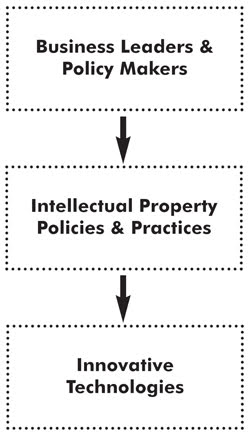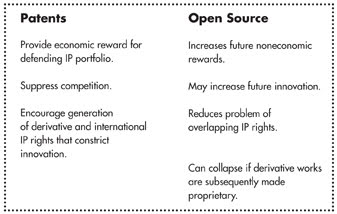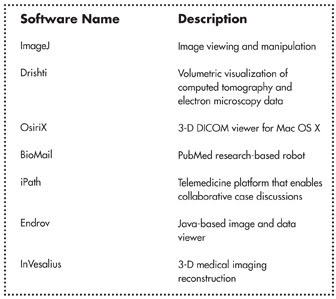Producing a winning idea is not an instantaneous
event but an ongoing process. Even if you are struck with an inspiration for a novel
technology, for a better way to accomplish an everyday task, or for a new application
or market for a biophotonics system, it didn’t spring from nowhere. Instead,
you processed a large set of data points – gathered from your experiences,
your colleagues and from a wider world – to reach a personal “eureka”
point.

Figure 1. Innovation, according to intellectual-property watchdogs, comes from careful handling
of patent holdings.
Today, however, biotechnology institutions of all kinds, including
commercial entities, academic and government laboratories, and nongovernmental organizations,
are looking for more certain ways to generate winning ideas. Increasing innovation
is the clarion call of the age.
Property values
Intellectual property (IP) is a keystone to biotech progress,
at least traditionally. Patents, the main form of IP that affects technology, have
helped individuals and companies ensure that they can profit from their ability
to create new technologies and processes.
Of late, however, flaws have begun to develop in the patent system.
Technology patents are growing in a nearly out-of-control fashion, choking off possible
innovations because of fears of litigation. Furthermore, vigorous efforts to protect
patents have made it difficult to import patented technologies to countries that
cannot afford the licenses or the means to develop their own competing technologies
(see Table 1).

Table 1. Patents vs. open-source information.
Overall, the IP landscape is becoming increasingly cluttered with
overly broad patent claims, lawsuits and controversy, leading some to advocate for
a new era of IP.
But traditional views of the ownership of ideas are changing,
especially when it comes to media and software programs. There now is a generation
of people who believe that free and open sharing of technology is the right thing
to do.
Epitomized by ImageJ, open-source software has quietly revolutionized
research. With just a little bit of programming skill, users can adapt ImageJ to
almost any imaging system or problem imaginable. Open-source software also is finding
use in the realm of bioimaging informatics, helping to carve through the terabytes
of image data generated by some technologies. Less well known software has sprung
up to address particular functions handy in academic labs, hospitals and clinics
(see Table 2).

Table 2. Select list of open-source software projects.
“Open-source technology is not necessarily better, or worse,
than that produced using standard commercial models,” said Jason R. Swedlow,
professor of quantitative cell biology at the University of Dundee in the UK. “However,
because open-source software is open, it is much easier to assess its quality and
utility.”
Open-source software tools for imaging are driven by the reputations
of the people involved in creating and improving it, Swedlow said. “The pressure
to excel and respond to the needs of the [user] community is very high.”
Choosing and integrating open-source software can be more complicated
than installing the commercial product that shipped with the microscope or other
instrument, but the trade-offs are program power and flexibility.
“Successful open-source projects will often have public
road maps, source code control, documentation, forums, etc., as well as a great
product,” Swedlow said. “It is now just easier to run a well-managed,
professional [imaging] operation and build great applications.”
The spreading use of open-source software in both academic and
commercial settings is encouraging thoughts of expanding the concept to hardware
and firmware; e.g., if an invention could be unshackled from its proprietary existence,
that would encourage cooperative exchanges between disparate users, each developing
novel twists on the invention to serve various applications of the technology.
Collaborative efforts
Cooperation and collaboration happen every day between commercial
enterprises and academic labs, especially between labs and their startups. They
also occur easily between companies and their clients, who often must work together
to solve technological hurdles that arise whenever a system is first installed or
when a repair or new application is called for.
Multidisciplinary interactions are commonplace in the fields that
incorporate photonics, but more are required. Collaborations occur between academic
scientists and the corporate engineers who deliver a new microscope system, for
example. To go further, communication must proceed to students, colleagues, other
potential microscope customers and members of the interested public, such as academic
officials. Engaging these minds, in a way that records the results, can generate
innovative ideas that can bear new technological fruit.
Interdisciplinary innovation requires letting go – of preconceptions,
of traditional ways of doing business and of old-fashioned turf wars. People create
and use technology with a goal in sight. Both makers and users of technology tend
to be reluctant to share information about that technology. There exists a mostly
unwarranted fear that sharing leads to loss of productivity or profits.
Independent agencies and individuals are needed to bridge the
gaps between industry, government, nongovernmental organizations and researchers.
The industrial sector fears losing profits because of “stolen” IP, the
government must record and defend patents, nongovernmental organizations are attempting
to disseminate useful technologies to less wealthy users, and researchers are trying
to generate novel technologies and products, often finding that generating profitable
IP is part of their jobs, even in academia.
The International Expert Group on Biotechnology, Innovation and
Intellectual Property calls these bridge makers “trust builders” because
they must help these institutions overcome their innate reluctance to share information
freely. The Montreal-based group asserts that all parties must become adept at listening
as well as talking as a way to become better sharers.
The group doesn’t leave the media out of its crosshairs,
either. Better communication of science and technology is a requirement of progress
toward better sharing and, therefore, more innovation.
One possible consequence is that merger and acquisition activity
will decrease. Small companies, including spinoffs from academic labs, often are
the targets of larger firms seeking to invigorate product lines through novel technologies.
Frequently, the ultimate target is not just any mature – or nearly so –
products the smaller company may have, it’s the IP portfolio it possesses.
The patents acquired then are turned into products and assimilated into the acquirer’s
own lines, or they are used to generate income off licenses or lawsuits.
Power from the people
At one time, developing an innovative idea – whether a new
product or a new way of doing business – was strictly a top-down process.
Upper-level managers were solely charged with creating and developing the ideas
that drove a company’s business. They may have encouraged brainstorming from
subordinates, but any ideas generated may or may not have percolated up through
the ranks of management to be seriously considered.
Increasingly, however, companies are looking to tap the collective
wisdom of their employees – at every level and from every discipline –
and their customers to generate the motive force behind innovation.
“The great companies engage their employees,” said
Bruce Strong, co-founder of CBridge Partners, a management-consulting firm based
in Cambridge, Mass. The failure to innovate comes from a misunderstanding of where
innovation originates – not from R&D, not from management and not from
consultants, but from employees, he said. Several high-tech companies already are
known for their employee-centered efforts. Google, for example, famously allows
staff members to use up to 20 percent of their time on developing new ideas unrelated
to their daily responsibilities.
Employees throughout an organization have untapped imaginations,
which Strong and his colleagues believe can be accessed through “innovation
communities,” or ICs. This model spurs management to gather staff members
from across various divisions, including product development, sales, distribution
and legal teams, to discuss a broad range of issues – even those unrelated
to technology or product development. Management must still assure that the best
ideas are acted upon, but the whole process gets creativity flowing, engaging everyone
in the company’s success, and improves the signal-to-noise ratio of profitable
ideas to lesser ones.
“ICs allow management to explain the company’s direction
and … employees to fill in the gaps of how to get there,” Strong said.
“ICs release a lot of energy.”
Some companies, such as General Electric Co., expand the notion
of ICs to include potential customers and the general public. These businesses understand
that well-run websites can help reduce the cost of failure when trying out new ideas,
whether products or processes. Customer outreach is vitally important to photonics
companies; problem solving before and after the purchase of a laser, imaging or
lighting system is a major cog in the innovation machine. Traditionally, this has
occurred in a narrow pipeline, in which a sales technician has been the sole connection
between a customer and a company.
Widening the communication channel by encouraging online interactions
can enable companies to perform “spaghetti on the wall” approaches to
acquiring, generating and testing new ideas with rapid customer input.
Testing new ideas once took a lot of time – years could
pass between receiving a nugget of an idea and realizing a new product from it.
By using the crowd-sourcing ability provided by a network of customers and colleagues
focused through one’s website and social media venues, idea generation and
validation become an ongoing stream. That stream, under the right conditions, can
become a torrent.
Re-examining the role of IP, considering the use of open-source
technologies, and interacting openly with clients, customers, colleagues and employees
at all levels will make certain that innovative ideas come fast and often.
“Imagine what hadn’t been imagined before –
that is the definition of innovation,” Strong said.